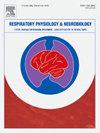评估呼吸困难程度时应考虑用力程度:一项临床研究。
IF 1.6
4区 医学
Q3 PHYSIOLOGY
引用次数: 0
摘要
背景/目的:运动性呼吸困难是心肺疾病的主要症状,限制了运动能力。多维度测量已被提议用于捕捉呼吸困难,但目前尚不清楚它是否有助于区分异常和正常呼吸困难强度的人。方法:这是一项对年龄≥18岁的门诊患者进行症状限制周期增量运动试验(IET)的随机对照试验的二次分析。使用运动后30分钟的多维呼吸困难谱(MDP)识别IET结束时的呼吸困难感觉,并比较异常高呼吸困难(Borg 0-10评级>正常上限[ULN])和正常范围内(≤ULN)的人(与规范参考方程定义的预测峰值功率输出百分比有关)。结果:在92名参与者中,20名(22%)有异常的高度呼吸困难。与正常呼吸困难组(n=72[78%])相比,异常组在运动高峰时的症状强度更高(7.9±1.7比6.3±1.4 Borg单位;P0.05):总体不愉快,4.1±2.3 vs 4.7±1.6;即时感知:10.9±2.8 vs 11.5±1.8;情绪反应,4.1±7.6 vs 3.2±7.5。MDP额定值与峰值输出功率无关。结论:在标准化IET峰值时,呼吸困难的维度相似,无法区分正常和异常高的运动性呼吸困难。本文章由计算机程序翻译,如有差异,请以英文原文为准。
Breathlessness dimensions should be evaluated in relation to the level of exertion: A clinical study
Background/aim
Exertional breathlessness is a dominating symptom in cardiorespiratory disease, limiting exercise capacity. Multidimensional measurement has been proposed to capture breathlessness, but it is unknown whether it is useful to differentiate people with abnormal vs normal exertional breathlessness intensity.
Methods
This was a secondary analysis of a randomized controlled trial of outpatients aged ≥ 18 years performing a symptom-limited cycle incremental exercise test (IET). Breathlessness sensations at end of IET were identified using the multidimensional dyspnea profile (MDP) 30-min post-exercise and compared between people with abnormally high breathlessness (Borg 0–10 rating > upper limit of normal [ULN]) and people within normal ranges (≤ ULN) in relation to the percentage of predicted peak power output defined by normative reference equations.
Results
Of 92 participants, 20 (22 %) had abnormally high breathlessness. Compared with those with normal breathlessness (n = 72 [78 %]), the abnormal group reported higher symptom intensity at peak exercise (7.9 ± 1.7 vs 6.3 ± 1.4 Borg units; p < 0.001) and had lower peak power output 129 ± 52 W vs 167 ± 55 W; p < 0.001). Differences between those with normal, and abnormal exertional breathlessness regarding MDP ratings were not statistically significant (all p > 0.05): overall unpleasantness, 4.1 ± 2.3 vs 4.7 ± 1.6; immediate perception, 10.9 ± 2.8 vs 11.5 ± 1.8; and emotional response, 4.1 ± 7.6 vs 3.2 ± 7.5. MDP ratings had no relation to peak power output.
Conclusion
Breathlessness dimensions are similar at the peak of a standardized IET and cannot differentiate between people with normal and abnormally high exertional breathlessness.
求助全文
通过发布文献求助,成功后即可免费获取论文全文。
去求助
来源期刊
CiteScore
4.80
自引率
8.70%
发文量
104
审稿时长
54 days
期刊介绍:
Respiratory Physiology & Neurobiology (RESPNB) publishes original articles and invited reviews concerning physiology and pathophysiology of respiration in its broadest sense.
Although a special focus is on topics in neurobiology, high quality papers in respiratory molecular and cellular biology are also welcome, as are high-quality papers in traditional areas, such as:
-Mechanics of breathing-
Gas exchange and acid-base balance-
Respiration at rest and exercise-
Respiration in unusual conditions, like high or low pressure or changes of temperature, low ambient oxygen-
Embryonic and adult respiration-
Comparative respiratory physiology.
Papers on clinical aspects, original methods, as well as theoretical papers are also considered as long as they foster the understanding of respiratory physiology and pathophysiology.

 求助内容:
求助内容: 应助结果提醒方式:
应助结果提醒方式:


